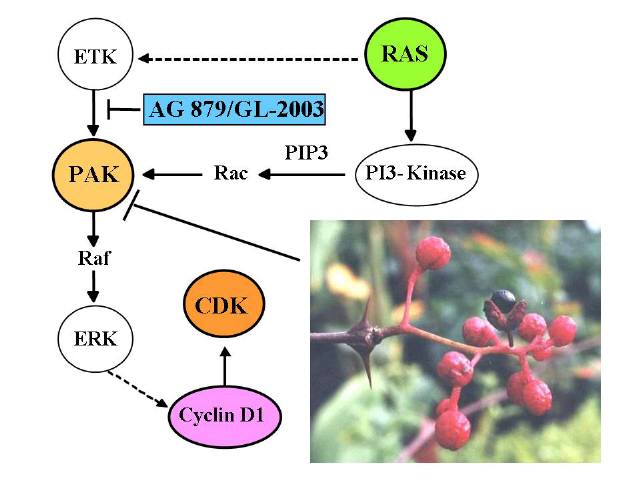NF Journal (Overseas Version);
News Letter (December 2005) from "NF CURE JAPAN"
A few months ago we have eventually launched our "NF CURE JAPAN",
the very first non-profit organization in Japan whose major mission is to support NF research
leading to the development of the first effective NF therapeutics that more than 1.5 million NF patients
on this planet have been long waiting for.
In the United States, Texas NF Foundation has played a leading role in supporting NF research,
by conducting the annual fund-raising campaign for Denise Terrill Charity Class (DTCC) Award,
dreaming that some days in the future the first effective NF therapeutics will be developed
and become available to any NF patients. Their persistent effort has been paid off slowly but steadily.
It has been known several years that Type 1 Neurofibromatosis (NF) is caused by a loss-of-function
mutation of NF1 gene which produces a RAS GAP, an attenuator of the normal GTPase RAS.
Thus, in tumors (Cafe-au-lait, neurofibromas or MPNST) of NF1 patients,
RAS is abnormally activated, and as a consequence the key kinase PAK1 is also abnormally activated.
Furthermore, it was recently found that Type 2 NF is caused by a loss-of-function mutation of
NF2 gene which produces a protein called Merlin that inhibits PAK1 (Hirokawa, Y. et al, 2004):
http://www.ncbi.nlm.nih.gov/entrez/query.fcgi?cmd=Retrieve&db=pubmed&dopt=Abstract&list_uids=15000491&query_hl=6
Thus, in tumors (meningiomas or schwannomas) of NF2 patients,
the same kinase PAK1 is abnormally activated.
In fact PAK1-inhibitors selectively inhibit the growth of NF1-deficient and NF2-deficient tumor cells.
There is a research group in Australia who has been developing a series of anti-PAK1 drugs,
in an attempt to cure RAS-induced cancers such as pancreatic and colon cancers,
simply because these cancers are highly addicted to PAK1 for their malignant growth.
Interestingly, some of these anti-PAK1 drugs such as FK228 strongly suppress
the growth of NF1-deficient tumor xenografts in mice (Hirokawa, Y. et al, 2005):
http://www.ncbi.nlm.nih.gov/entrez/query.fcgi?cmd=Retrieve&db=pubmed&dopt=Abstract&list_uids=15846074&query_hl=6
Among them the Sichuan red peppercorn (Zanthoxyli fructus) from China sounds most attractive,
because it is one of the most popular Chinese traditional seasonings available in most of oriental grocery shops,
and it is very cheap (costing only US$3.00 for 100 g). This pepper contains an anti-PAK1 ingredient.
http://www.landesbioscience.com/journals/cbt/abstract.php?id=2404
 Currently our "NF CURE JAPANh is organizing an international team of Chinese and NZ companies
who are willing to produce a new healthcare food supplement called gHoney Peph by blending
the water/ethanol soluble extract of this peppercorn with NZ honey for the first "home trials"
(phase 1, for gsafetyh check only ) of NF (both NF1 and NF2) in Japan and probably
the United States in a not-too-distant future.
The above animal data were presented at US NF Conference in Utah during June 10-12, 2007 (for detail, see below):
nfj_2007_0610
Currently our "NF CURE JAPANh is organizing an international team of Chinese and NZ companies
who are willing to produce a new healthcare food supplement called gHoney Peph by blending
the water/ethanol soluble extract of this peppercorn with NZ honey for the first "home trials"
(phase 1, for gsafetyh check only ) of NF (both NF1 and NF2) in Japan and probably
the United States in a not-too-distant future.
The above animal data were presented at US NF Conference in Utah during June 10-12, 2007 (for detail, see below):
nfj_2007_0610
Return to NFJ INDEX
Copyright (C) 2005 Hiroshi Maruta, DAIKON_TOM. All Rights Reserved.
Modify 2005. Dec. 12 Ver 1.0
Modify 2006. Aug. 8 Ver1.1
Modify 2007. Jun. 13 Ver1.2
 Currently our "NF CURE JAPANh is organizing an international team of Chinese and NZ companies
who are willing to produce a new healthcare food supplement called gHoney Peph by blending
the water/ethanol soluble extract of this peppercorn with NZ honey for the first "home trials"
(phase 1, for gsafetyh check only ) of NF (both NF1 and NF2) in Japan and probably
the United States in a not-too-distant future.
The above animal data were presented at US NF Conference in Utah during June 10-12, 2007 (for detail, see below):
nfj_2007_0610
Currently our "NF CURE JAPANh is organizing an international team of Chinese and NZ companies
who are willing to produce a new healthcare food supplement called gHoney Peph by blending
the water/ethanol soluble extract of this peppercorn with NZ honey for the first "home trials"
(phase 1, for gsafetyh check only ) of NF (both NF1 and NF2) in Japan and probably
the United States in a not-too-distant future.
The above animal data were presented at US NF Conference in Utah during June 10-12, 2007 (for detail, see below):
nfj_2007_0610